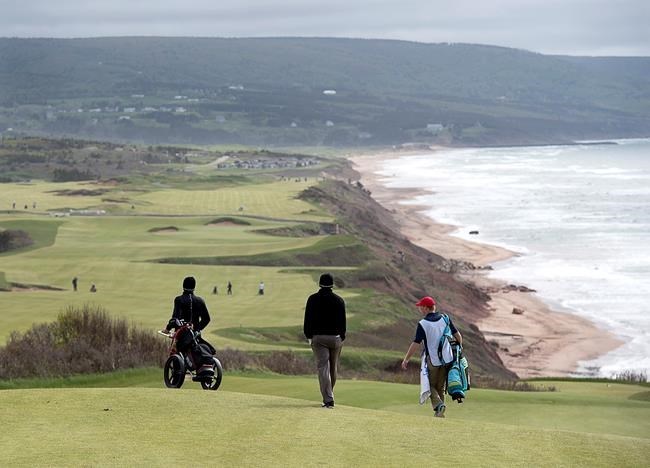
Golfers walk off the 331 yard, par 4, 17th hole at Cabot Cliffs, the seaside links golf course rated the 19th finest course in the world by Golf Digest, is seen in Inverness, N.S. on Wednesday, June 1, 2016. Located between the coal mining town of Inverness and the Gulf of St. Lawrence, the sister course to Cabot Links is receiving rave reviews and drawing international attention. THE CANADIAN PRESS/Andrew Vaughan
June 02, 2016 - 9:04 AM
INVERNESS, N.S. - Golf in North America is in the grips of a fixation with remote, relatively inaccessible resort courses that offer authentic, old-world links-style layouts where riding in carts is frowned upon, if not forbidden, and a caddie with local knowledge is a must.
Patience is also a virtue; the appeal of these courses, many of them seaside layouts, is that they offer a true test of golf, which usually means a combination of brawny holes, unforgiving bunkers and relentlessly difficult conditions. Here are a few examples:
Cabot Links Golf Resort: The first 18-hole course, built on an abandoned mine site at the edge of Inverness, N.S., hard by the Gulf of St. Lawrence on Cape Breton Island, opened to rave reviews in 2012. But the buzz that surrounded Cabot in those heady days has been eclipsed by the excitement over its sister course, Cabot Cliffs, which opens officially on June 8. Critics have likened its spectacular four-hole closing stretch to California's Cypress Point, one of the most famous — and exclusive — clubs in the world.
Sand Valley Golf Resort: The latest brainchild of Mike Keiser, the father of the 'remote golf' phenomenon and Ben Cowan-Dewar's partner in the Cabot Links project. Wisconsin's Sand Valley — named for towering exposed sand dunes that once comprised the bottom of a glacial lake — will have a Coore-&-Crenshaw layout in place when it opens for business in 2017, with another 18 holes designed by David Kidd to follow.
Sand Hills Golf Club: Arguably the golf course that started it all in 1995, Nebraska's private Sand Hills Golf Club — again designed by Coore and Crenshaw — takes advantage of topography and drainage characteristics similar to Sand Valley, allowing for firm, fast fairways, windswept putting surfaces and daunting bunkers that recall the classic links courses of the Scottish coast. Getting there is no picnic: Sand Hills is a five-hour drive from the nearest major airports, and the local town, Mullen, Neb., is home to just 500 people.
Streamsong Resort: Opened in 2013, Streamsong is located in central Florida with two 18-hole layouts: one, the Blue, designed by Tom Doak; the other, the Red course, was designed by none other than Coore and Crenshaw. The resort is an offshoot of a nearby phosphate-mining operation run by the Mosaic Company, the loamy, sandy terrain a byproduct of a long-dead such mine.
Bandon Dunes Golf Resort: The golf standard, owned by Keiser and widely credited as the reason it's hard to find a golf development these days that isn't high-end and located in or near the middle of nowhere. Since opening in 1999, Bandon now boasts five of the finest links-style layouts in the world, and provides the template for successful projects like Cabot Links. Golf Magazine rates four of its courses — Pacific Dunes; Bandon Dunes; Old Macdonald; and Bandon Trails — in the top 13 of its Top 100 public courses in the United States.
News from © The Canadian Press, 2016